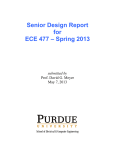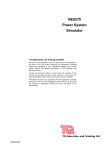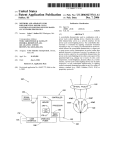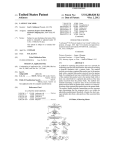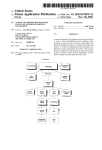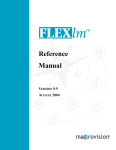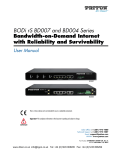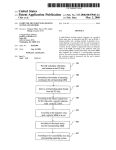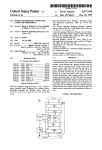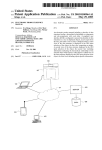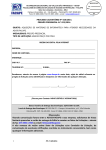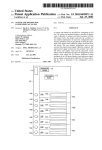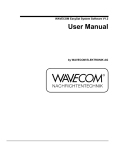Download Methods and systems for image sharing over a network
Transcript
US 20050052685A1 (19) United States (12) Patent Application Publication (10) Pub. No.: US 2005/0052685 A1 Herf et al. (54) (43) Pub. Date: METHODS AND SYSTEMS FOR IMAGE SHARING OVER A NETWORK Mar. 10, 2005 Publication Classi?cation (51) Int. Cl.7 ................................................... .. G06F 15/00 (52) US. Cl. ......................................... .. 358/115; 358/402 (76) Inventors: Michael Herf, Studio City, CA (US); Brian McBarron, Harrison City, PA (Us) Corres ondence Address: KNOPIJBE MARTENS OLSON & BEAR LLP (57) ABSTRACT 2040 MAIN STREET _ FOURTEENTH FLOOR IRVINE, CA 92614 (Us) designates an image recipient. Metadata for the ?rst image is transmitted from the ?rst user’s terminal to the image May 17’ 2004 the metadata, the image recipient’s terminal transmits a Related US Application Data request for the ?rst image at a ?rst resolution to the ?rst user’s terminal. In response to the request, the ?rst user’s _ (60) _ 10/847,536 (21) Appl- NO-I (22) Flled: _ Methods and systems are provided for sharing images over a network. A ?rst user selects an image for sharing and recipient’s terminal. At least partly in response to receiving Provisional application No, 60/471,168, ?led on May 16, 2003. terminal transmits the ?rst image at the requested ?rst resolution to the image recipient’s terminal. COMPUTER A FILE SHARING APPLICATION COMPUTER A INFORMS COMPUTER B ABOUT IMAGEI BY TRANSMITTING KEYI TO IDENTIFY THE IMAGE I //4 COMPUTER B REQUESTS IMAGEI BY SPECIFYING A DESIRED RESOLUTION AND IDENTIFYING THE 705 KEY COMPUTER B FILE SHARING APPLICATION KEYI m9 COMPUTER A RESPONDS BY SENDING A RESIZED VERSION OF IMAGEI Patent Application Publication Mar. 10, 2005 Sheet 1 0f 7 706’ US 2005/0052685 A1 ///0 IMAGE1 COMPUTER A FILE SHARING APPLICATION COMPUTER A INFORMS COMPUTER B ABOUT IMAGEI BY TRANSMITTING KEY1 TO IDENTIFY THE IMAGE 7/4 NETWORK /06\\ COMPUTER B REQUESTS IMAGEI BY SPECIFYING A DESIRED RESOLUTION AND IDENTIFYING THE KEY COMPUTER A RESPONDS BY SENDING A RESIZED VERSION OF IMAGEI I COMPUTER B KEY1 FILE SHARING APPLICATION 709/ [/61 1 I12 Patent Application Publication Mar. 10, 2005 Sheet 2 0f 7 NRN US 2005/0052685 A1 Patent Application Publication Mar. 10, 2005 Sheet 3 0f 7 US 2005/0052685 A1 4E EB_vHQc!ES s M$135“. .b. Qtan-aw Patent Application Publication Mar. 10, 2005 Sheet 4 0f 7 US 2005/0052685 A1 .3rW,2312 Patent Application Publication Mar. 10, 2005 Sheet 5 0f 7 US 2005/0052685 A1 lgs“ 2N53i2:6c5“ :..1i2. 32EEPKGa13i.S5qm:tg %\\QN Patent Application Publication Mar. 10, 2005 Sheet 6 0f 7 3:51 -#280 Qchi-:6 US 2005/0052685 A1 Eésio 9.5‘x2ir.91;?!5.1: I. .neg R52h..i21._0E5a 3:* .~ .E2aulva) Patent Application Publication Mar. 10, 2005 Sheet 7 0f 7 US 2005/0052685 A1 K502 PEER A 255%; DCP SERVER UDP PACKET To DCP SERVER SENDS EXTERNALLY VISIBLE ADDRESS OF PEER B J/6\ \ PEERS A AND B SEND UDP PACKETS 505\ AND ESTABLISH CoNNECTIoNS ‘ DCP SERVER PEER B 'DCP SERVER SENDS UDP _ SENDS EXTERNALLY PACKET T0 DCP SERVER VISIBLE ADDRESS OF PEER A ‘ PEER B 4 [J0 Mar. 10, 2005 US 2005/0052685 A1 METHODS AND SYSTEMS FOR IMAGE SHARING OVER A NETWORK PRIORITY CLAIM [0001] This application claims the bene?t under 35 U.S.C. 119(e) of US. Provisional Application No. 60/471,168, ?led May 16, 2003, the contents of Which are incorporated herein in their entirety. select and transmit images at the appropriate resolution. HoWever, this approach is often of little use Where the sending server does not knoW the resolution and/or type of requesting terminal. Yet other conventional systems store several versions of each image at several different resolu tions in order to accommodate different resolution requests. Such storage of multiple versions can signi?cantly increase the needed available storage memory. SUMMARY OF THE INVENTION Copyright Rights [0002] Aportion of the disclosure of this patent document contains material that is subject to copyright protection. The copyright oWner has no objection to the facsimile reproduc tion by any one of the patent document or the patent disclosure, as it appears in the Patent and Trademark Of?ce patent ?le or records, but otherWise reserves all copyright [0011] The present invention provides methods and sys tems for retrieving and transmitting digital images over a netWork. One embodiment enables users to automatically gain resolution-independent access to ?les remotely via a permissions model. Further, one embodiment enables a ?rst user to transmit large numbers of image ?les to second user using a relatively small amount of bandWidth. rights Whatsoever. [0003] BACKGROUND OF THE INVENTION [0012] In one eXample embodiment, a sending user sends permission data regarding one or more images to a recipient user’s terminal. The recipient user’s terminal can use the 1. Field of the Invention permission data to request images at desired resolutions, [0004] The present invention is related to image transmis sion and retrieval, and in particular, to methods and systems for transmitting and retrieving digital images over a net Work. such as thumbnail images of very loW resolution, to thereby reduce the time it takes for the transmitting terminal to send the images over a netWork to the recipient terminal. The user can then select one or more of the thumbnails for Which the user Would like to receive a relatively higher resolution (if [0005] 2. Description of the Related Art still loW or medium resolution) image. The relatively higher [0006] Many applications use network protocols to trans mitting terminal to the recipient terminal. The recipient can fer digital media ?les from one computer over a netWork to another computer. By Way of eXample, When users request images via the World Wide Web, HTTP protocol is conven tionally used to transmit the requested images encoded as JPEG ?les to the users. This type of access is commonly referred to as a “pull” protocol because users request each image through the use of a Web broWser. [0007] Further, many conventional Web sites that provide vieWs of image data require users to upload original pictures or other image ?les, Which can total hundreds of megabits of transfer and hours of upload time, even if the pictures are never actually vieWed by others. [0008] Users also conventionally send digital pictures through email in order to “push” ?les to other users. Users can search for ?les on a number of peer-to-peer (or “p2p”) netWorks to ?nd image ?les to doWnload and share With others. The foregoing methods are ?le-based, Wherein the request mechanism asks for the contents of a ?le and those contents are transferred over a netWork. In particular, With respect to image ?les, these methods can sometimes require that the sender send images using a ?Xed image resolution, Which is the ?le received by the recipient. [0009] Further, emailing large, high resolution pictures can cause large doWnload times for the recipients, can tie up their netWork access and their computer, and so sending many pictures this Way is often considered rude. When small pictures are sent via email, the process is generally accom plished manually, by repeated emails and resiZing operations to obtain the desired resolution, Which is tedious, dif?cult, and time consuming for the average user. [0010] Still other conventional methods necessitate that the sending server knoW the resolution and/or terminal type of the requesting terminal so that the sending server can resolution images can then be transmitted from the trans select one or more of the loW-resolution or relatively higher resolution images for Which the recipient Would like still higher resolution or Zoomed versions. For eXample, the recipient can selectively request the highest available reso lution ?le image for one or more images. [0013] The resolution values of the delivered images are optionally determined, at least in part, by the recipient, and the requested resolution values do not have to be remem bered or previously knoWn by the transmitting terminal. [0014] One eXample embodiment provides a method of peer-to-peer sharing of images over a netWork, the method comprising: receiving a selection of a ?rst image by a user of a sending peer terminal, Wherein the ?rst image has a ?rst resolution; transmitting over a netWork permission data for the selected ?rst image from the sending peer terminal to a receiving peer terminal, the permission data including at least image identi?cation information and resolution infor mation, the resolution information specifying a second reso lution less than the ?rst resolution; automatically transmit ting an image request for the ?rst image from the receiving peer terminal to the sending peer terminal, Wherein the image request is based at least in part on the permission data image identi?cation information and resolution information; and in response to receiving the image request, the sending peer terminal scaling ?rst image to the second resolution, encrypting the scaled ?rst image, and transmitting over the netWork the encrypted ?rst image at the second resolution to the receiving peer terminal. [0015] Another eXample embodiment provides a peer-to peer image sharing application for sharing images betWeen users, the peer-to-peer image sharing application comprising instructions stored in computer readable memory con?gured to: receive a selection of a plurality of images by a ?rst user Mar. 10, 2005 US 2005/0052685 A1 of a ?rst terminal; receive a send image command from the ?rst user; cause a list of potential recipients to be displayed resolution and transmitting the scaled ?rst image to the receiving terminal in response to receiving the image to the ?rst user; receive a selection of at least a ?rst recipient request. from the list of potential recipients from the ?rst user; transmit permission data for the plurality of images to a terminal associated With the ?rst recipient; receive a request from the terminal associated With the ?rst recipient, the request identifying the plurality of images and a ?rst BRIEF DESCRIPTION OF THE DRAWINGS [0020] FIG. 1 illustrates an example system architecture and image ?le access process. requested resolution for the plurality of images; and transmit [0021] to the terminal associated With the ?rst recipient the plurality of images at the ?rst requested resolution so that they appear on a display of the terminal substantially instantly. [0022] FIG. 3 illustrates an example system architecture and peer-to-peer connection process using an enhanced [0016] FIGS. 2A-2E illustrate example user interfaces. connection protocol. Still another example embodiment provides a peer to-peer image sharing program for sharing images betWeen users, the peer-to-peer image sharing application comprising DETAILED DESCRIPTION OF PREFERRED EMBODIMENTS instructions stored in computer readable memory con?gured [0023] Throughout the folloWing description, the term to: receive at a ?rst terminal permission data for an image stored on a sending user’s terminal; at least partly in response to receiving the permission data, automatically transmit from the ?rst terminal a request for the image to the sending user’s terminal, the request specifying a ?rst requested image resolution; receive at the ?rst terminal the image at the ?rst requested image resolution from the sending user’s terminal; and cause the image to be displayed at the ?rst requested image resolution on a ?rst terminal display. [0017] Yet another example embodiment provides a method of peer-to-peer sharing of images, the method com prising: receiving a selection of a ?rst image by a ?rst user of a ?rst terminal; receiving a recipient selection by the ?rst user; transmitting metadata for the ?rst image from the ?rst “Web site” is used to refer to a user-accessible server site that implements the basic World Wide Web standards for the coding and transmission of hypertextual documents. These standards currently include HTML (the Hypertext Markup Language) and HTTP (the Hypertext Transfer Protocol). It should be understood that the term “site” is not intended to imply a single geographic location, as a Web or other netWork site can, for example, include multiple geographi cally distributed computer systems that are appropriately linked together. Furthermore, While the folloWing descrip tion relates to an embodiment utiliZing the Internet and related protocols, other netWorks, such as networked inter active televisions, and other protocols may be used as Well. terminal to a second terminal associated With a second user; [0024] In addition, unless otherWise indicated, the func tions described herein are preferably performed by softWare modules including executable code and instructions running at least partly in response to receiving the metadata, the second terminal automatically transmitting a request for the on one or more general-purpose computers. The computers can include one or more central processing units (CPUs), ?rst image at a ?rst resolution to the ?rst terminal; and in response to the request, the ?rst terminal automatically including one or more of volatile memory, such as random transmitting the ?rst image at the requested ?rst resolution that execute program code and process data, memory, to the second terminal. access memory (RAM) for temporarily storing data and data structures during program execution, non-volatile memory, [0018] Another example embodiment provides a method of peer-to-peer sharing of images, the method comprising: such as a hard disc drive, optical drive, or FLASH drive, for storing programs, data, and databases, and one or more netWork interfaces for accessing an intranet and/or Internet. receiving permission data for a ?rst image from a ?rst terminal, the permission data including an identi?er for the ?rst image; at least partly in response to receiving the [0025] In addition, the computers can include a display for displaying user interfaces, data, photographs, images, and permission data, automatically transmitting at least a ?rst the like. The computers can also include one or more user request for the ?rst image at a ?rst resolution to the ?rst input devices, such as a keyboard, mouse, pointing device, microphone and/or the like, used to navigate, provide com mands, enter information, and/or the like. HoWever, the present invention can also be implemented using special purpose computers, state machines, and/or hardWired elec tronic circuits. In addition, the example processes described terminal, the at least ?rst request including the ?rst image identi?er and user identi?cation; receiving the ?rst image at the requested ?rst resolution; and automatically causing the ?rst image to be displayed to a receiving user. [0019] Still another example embodiment provides a method of sharing of images, the method comprising: receiving a selection of a ?rst image by a user of a sending terminal, Wherein the ?rst image has a ?rst resolution; herein do not necessarily have to be performed in the described sequence, and not all states have to be reached or performed. transmitting permission data for the selected ?rst image [0026] Further, While the folloWing description may refer from the sending terminal to a receiving terminal, the to “clicking on” a link or button, or pressing a key in order to provide a command or make a selection, the commands permission data including at least image identi?cation infor mation; receiving at the sending terminal an image request from the receiving peer terminal, Wherein the request is for or selections can also be made using other input techniques, the ?rst image and is based at least in part on the identi? cation information and speci?es a second resolution loWer over an input area, selecting menu options, and/or the like. In addition, While certain processes and functions may be than the ?rst resolution; and scaling ?rst image to the second described as being performed separately by a ?le sharing such as using voice input, pen input, mousing or hovering Mar. 10, 2005 US 2005/0052685 A1 application and an image management application, the pro cesses and functions can be performed by the same appli cation. [0027] The present invention provides methods and sys tems for sending and retrieving digital images over a net Work. As Will be discussed in greater detail herein, an example embodiment enables users to selectively gain access to multiple resolution versions of image ?les over a netWork. In one embodiment, these resolution values are determined, at least in part, by the recipient or recipient terminal, Which sends a request for images at the desired resolution to the transmitting system. Optionally, the request can be a single request for the images, or the request can be HTTP and accessible via Web broWsers. Many of these systems are based on tiled representations of an image (Which the client can reconstruct into image data through broWser plug-ins), but arbitrary-siZe requests have also been implemented previously. In practice, Web sites that provide vieWs of users’ image data to others typically require users to upload original pictures in the form of image ?les, Which can total hundreds of megabits of transfer and hours of upload time, even if the pictures are never actually vieWed by others. [0031] Further, using conventional techniques, emailing large pictures causes huge doWnload times for the recipients, and sending many pictures this Way is considered rude. in the form of a separate request for each of the images, Wherein the separate requests can be transmitted sequen tially and can optionally be transmitted at the same or substantially the same time as permission data for additional When small pictures are sent via email, the process is images is being received. The transmitting system can optionally process and siZe the images to the requested [0032] By contrast, one embodiment of the image sharing accomplished manually, by repeated emails and resiZing operations, Which is tedious, dif?cult, and time consuming for the average user. process provided herein can be referred to, for convenience, resolution on the ?y in response to the recipient’s or the as a “hybrid push-pull model.” Amachine, such as a terminal recipient’s terminal request. Thus, prior to the recipient (Which can be a networked desktop computer, server, per terminal’s request, the transmitting system does not have to knoW Which versions of the images Will be requested or have to pre-store versions of the images at the requested resolu tions. telephone, image server, or the like, Which may be referred [0028] For example, the recipient can select a picture resolution corresponding to a thumbnail. When the thumb sonal digital assistant, personal video recorder, cellular to for convenience as the “server” or “sender”) makes available one or many ?les by transmitting permission data to a receiving peer (Which can be a netWorked desktop computer, server, personal digital assistant, personal video recorder, cellular telephone, image server, or the like, Which nail image is displayed, the recipient can then click on the thumbnail and a higher resolution version of the picture is quickly doWnloaded from the sender’s computer, Wherein “recipient”). The receiving peer, remembering, retrieving the picture resolution can be selected based on that desired for on-screen vieWing of a 5 inch><3.5 inch version of the thereof, back to the sender, can repeatedly request versions picture, 4 inch><7 inch version of the picture, a 5 inch ><7 inch version of the picture, an 8 inch by 10 inch version of the picture, a full screen version of the picture, and so on. Once the recipients have received the relatively higher resolution images, the recipient can then optionally selectively doWn load still higher resolution or print quality copies of the may be referred to for convenience as the “receiver” or the and transmitting this permission data, or selected portions of the image by specifying a siZe (expressed, by Way of example, as a bounding box) that the remote sender responds to With image data. Optionally, the receiver can request the binary contents of the original ?le, Which is an operation supported by existing transfer protocols. [0033] Using the “push” nature of the protocol described pictures the user is interested in. The recipient can then print the still higher resolution or print quality pictures at home or the of?ce using a color printer. herein, a user does not have to knoW about an image [0029] Optionally, the sharing applications automatically versions thereof over an extended period and optionally over resource before gaining access to it. Additionally, persis tence of permission information may be provided on the client, so that the recipient maintains access to the ?le and transfer both the thumbnail version of the images and the multiple resolution requests. next highest resolution, such as the screen resolution, ver [0034] sion of the images to the receiving terminal before the receiving user actually selects an image. Thus, in response to the receiving user clicking on a thumbnail version of an image, the screen version of the image is instantly presented as it is already stored on the receiving user’s terminal. Optionally the transfer of the tWo versions of a given image is prioritiZed so that the transfer of the loWer resolution, thumbnail version, of the image is given a higher priority than the relatively higher, screen resolution version of the image. In an example embodiment, Where several images are to be transferred, the thumbnail versions are transferred ?rst, and then the relatively higher resolution versions are automatically transferred from the sending terminal to the receiving terminal. [0030] With respect to conventional picture sharing sys tems, because Web servers can be highly customiZable, resolution-independent access to pictures (including Zoomed subsections) has been conventionally implemented over Thus, using an embodiment of the method described herein enables a user to share ?les, such as loW resolution versions of image ?les, With another user using little or substantially no bandWidth. Further, the method described herein enables users to select the desired resolu tion version of the image. For example, a user may transmit permission for 100 ?les totaling 100MB of raW data. Thus, in contrast to conventional methods, Which might, in this example, transfer the 100MB of raW data betWeen the peers, the receiving terminal may request thumbnails totaling 200KB, “previeWs” (Which can be for example, 1280x960 pixels) for a selection of images totaling 500KB, and origi nal data for only 2 more ?les, totaling 2MB. In the example given, the netWork bandWidth used has been reduced by more than a factor of 30, as compared With the transfer of all the original, full resolution images, With no prior knoWledge by the sender of hoW the images Would be used. [0035] For applications Where access to the original ?les should be protected, such as online art sales, the ?le sharing Mar. 10, 2005 US 2005/0052685 A1 application enables a user to specify the maximum siZe or via a Web cam or other camera or image capture system resolution available to requesters. Optionally, different coupled to the user terminal. For eXample, in one embodi requesters can have access to different image siZes or ment, the user can click on an image capture button Which Will cause a picture to be captured by the Web cam or other camera. The user can then specify With Whom from the user’s contact list the image or images are to be shared via a dialog boX or otherWise as similarly discussed above. resolution. For example, a print-resolution ?ne art Work may be stored at a very high resolution, but may be limited by the sender to a siZe of 640x480 piXels With respect to transmis sion to recipients via the ?le sharing application. Optionally, the sender can specify that certain recipients, such as paying recipients or speci?ed friends or coWorkers, can access [0042] higher resolution or full resolution versions of the images. shots of Web pages via the ?le sharing application. For [0036] To accomplish this, in an eXample embodiment, the sender ?le sharing application eXamines the ?le’s actual eXample, the user can open a broWser or other Web access siZe, the sender’s maXimum siZe or resolution to send, and the recipient’s request siZe or resolution. Thus, the version Optionally, the user can also share images or snap application and then click an image capture button. Clicking the image capture button Will cause the ?le sharing appli of the image Will be substantially equal to the smaller of the cation to capture an image of the Web page and open the ?le sharing dialog boX. The user can then select With Whom the requested resolution and the maXimum resolution or siZe Web page image Will be shared With. The recipients of the speci?ed by the sender. The sender ?le sharing application resiZes the picture in question to this siZe using high-quality methods, such as bicubic resampling of the original image their ?le sharing application and their broWser Will open to ?le, and then sends a compressed ?le, Which is optionally encrypted, to the recipient. In one embodiment, the encryp image can then click on the Web page image as presented in that Web page. performed, by Way of eXample, on a stream level, Wherein [0043] FIG. 1 includes an eXample netWorked system and How diagram of a hybrid push-pull method used to share images. As illustrated in FIG. 1, a peer terminal Computer the peer stream is itself encrypted and/or on a component A 110 is associated With a sending user. The peer terminal tion is provided on a stream level. The encryption can be level, Wherein, for eXample, individual items and ?les are encrypted. [0037] In one embodiment, the sender selects the pictures or images to be shared using an image management appli cation. For convenience, in the folloWing description the phrases “picture” or “pictures” includes pictures or images, such as pictures or images in a JPEG compliant format, as Well as other types of images, such as bmp or gif images or graphic ?les. Optionally, the image management application can be integrated With the ?le sharing application. The image management application can display on a user termi nal screen one or more pictures, or thumbnails or reduced siZed versions of the pictures. [0038] In an eXample embodiment, as pictures are selected thumbnails thereof are displayed and grouped in another area of the screen, such as at the bottom, top right side, or left side of the screen. Once the user has ?nished selecting all of the pictures the user Wants to share in a given sharing session, the user can click on a ?le sharing button. The screen presented on the user’s terminal Will then sWitch to the ?le sharing application and a ?le sharing dialog boX or menu is presented. [0039] One or more names or identi?ers are presented via a dialog boX, menu, address book, or the like, that corre spond to other users. The user can select picture recipients by clicking on one or more of the presented user names or identi?ers and then clicking on a send button. Optionally, after the selected pictures have been sent, images thereof are placed or remain in a “recent pictures” tray or ?le for quick access by the sender so that they can be quickly accessed and sent by the sender to other users. [0040] Optionally, the ?le sharing application protects against viruses by automatically con?rming that picture ?les are valid picture-type ?les, such as a J PG or TIFF ?le, before alloWing them to be shared. Thus, the ?le sharing application prevents the sharing and transmission of viruses. [0041] In an eXample embodiment, the shared pictures can be pictures captured in real time or in substantially real time Computer A 110 can be, by Way of eXample, a netWorked desktop computer, server, personal digital assistant, personal video recorder, cellular telephone, image server, or the like, is coupled via a netWork 114 to a peer terminal Computer B 112 associated With a receiving user. The receiving peer terminal Computer B 112 can be, by Way of eXample, a netWorked desktop computer, server, personal digital assis tant, personal video recorder, cellular telephone, image server, or the like. While, for the purposes of clarity, the peer terminal Computer A 110 is referred to as the sending peer terminal, it can also act as the receiving peer terminal. Similarly, the peer terminal Computer B 112 is referred to as the receiving peer terminal, it can also act as the sending peer terminal. By Way of eXample, the netWork 114 can include one or more of the Internet, an intranet, a Wide area netWork, and a local area netWork. [0044] The sending and receiving peer terminals, Com puter A 110 and Computer B 112, can each include Web broWsers, image management applications, ?le sharing applications 111, 113, netWork interfaces, email clients, and images, such as pictures. The ?le sharing applications 111, 113 can be doWnloaded from a Web site or other computer to Computer A 110 and/or Computer B 112, installed via computer readable removable storage media, come prein stalled on the computers’ mass memory, or otherWise loaded. The images or pictures can be stored in local computer memory, or storage devices accessible by the peer terminal over a local netWork, and so on. [0045] The ?le sharing applications 111, 113 can also optionally include integrated image management and editing functions, or those functions can be provided by a separate image management application (not shoWn). For eXample, the image management and edit functions can include one or more of automatically searching for images stored on the computer’s drive and/or over a netWork, setting up image albums, assigning images to the image albums, assigning titles and/or key Words to images, searching for or sorting images based on album titles, picture titles, and/or key Words, and dates. The image management and edit functions Mar. 10, 2005 US 2005/0052685 A1 can further include one or more of cropping images, reduc (HyperText Transfer Protocol), Which is used in moving ing red eye, enhancing image color and/or contrast, and so hypertext ?les across the Internet. on. [0046] At state 102, the sending terminal ComputerA110, via the ?le sharing application 111, makes available one, several, or many image ?les by transmitting or pushing permission data Key1109 over the netWork to the receiving [0049] In this example, at state 104, Computer B 112 requests Image1108 from ComputerA 110 by identifying the requested image using Key1109 and specifying the desired peer terminal Computer B 112. The permission data can provide authoriZation to access images selected by the sending user. The permission data can be in the form of resolution, such as 96 pixels by 96 pixels for a thumbnail siZe image, or 640 pixels by 480 pixels for a screen siZe version of the image. Of course other thumbnail resolutions, such as 64x64 pixels, 128 pixels by 128 pixels, or 160 pixels alphanumeric metadata. An illustrative example of permis by 160 pixels. The request is transmitted to Computer A 110. sion metadata is as folloWs: For example, an example request can be in the form of: [0047] The example permission metadata above includes [0050] an image identi?er (image iid), a user identi?er (uid), a machine identi?er (mid), a second user identi?er (uid), an can optionally be based on, or include: image Width (Width), an image height (height), a container [0051] sending user Who shared the image [0052] to the machine that Will transmit or otherWise share the image [0053] c) a local image identi?er of the image (such as the image identi?er received in the permission data for the image), Which can be speci?c to the particular user on the particular machine. provided With an appropriate length identi?cation code. Further, other data can be included, such as an access code or passWord. Optionally, the Key1 can have an expiration date and/or a limit on the number of times it can be used to retrieve the corresponding image ?le or ?les. By Way of b) a machine identi?er (such as that received in the permission data for the image) corresponding Other forms of permission data can be used as Well. For example, the permission data need not include a container identi?er, a ?le modi?cation time, or other of the above data items. In addition, the unique image identi?er can instead be a) a user identi?er (such as that received in the permission data for the image) corresponding to the or ?le identi?er or hint (container), an image ?le name (?lename), an image ?le siZe (?lesiZe), a ?le content signa ture (md5), a ?le modi?cation time (?lemodetime). Aunique image ID is de?ned by the combination of the image identi?er, the user identi?er, and the machine identi?er. 1. A global image identi?er for the image Which [0054] 2. The Width and height of the bounding box, each expressed as integers, though the siZe and/or resolution can also be otherWise expressed. example, in an embodiment, the sending terminal or server maintains a count of hoW many times a given image ?le had [0055] In the example embodiment, because connections been retrieved, and/or When the ?le Was initially shared, and stores that data in association With the per-user permission are authenticated, implicit in the request is the ID or iden ti?er of the requesting user, Which is used at the ACL (access data for the ?le. The sender application can then check the number of times the ?le has been retrieved by a requesting user, compare that number to the permitted number of retrievals, and determine if that number has been reached, control list) level, discussed beloW. Therefore, the requesting user identi?er is optionally not explicitly included in the image request, and so user spoo?ng is further inhibited. Optionally, hoWever, the requesting user’s identi?er can be again. Similarly, the expiration date and determine if that included in the request, preferably before the request reaches the security layer, Which can determine Whether it is alloWed date and has passed, and so Whether or not to alloW the user or not alloWed. and so Whether or not to alloW the user to access the ?le to access the ?le. [0056] Optionally, in one embodiment a user can request a Zoom or resiZing of a shared image, Wherein the user can [0048] The receiving peer terminal Computer B 112, remembering and storing Key1109 and associated permis specify or select a portion of a shared image. The portion can sion data in local memory, can use Key1 or a portion thereof, be selected by draWing or de?ning a border surrounding the desired portion. The image sharing application then issues a and ?le sharing application 113 to automatically make one or more requests for the same or different versions of a given image by specifying a siZe (Which, for example, can be expressed as abounding box) that the remote sender Com puter A 110 automatically responds to by transmitting the requested image data to the receiving peer terminal Com puter B 112. Alternately or in addition, the receiving peer terminal Computer B 112 can request the binary contents of the original ?le, Which is an operation supported by existing or yet to be developed transfer protocols, such as HTTP request for the Zoomed portion using the image identi?er information and bounding box information described above, and by further including the folloWing parameters in the request: [0057] Scale [0058] Translate X, [0059] Translate Y Mar. 10, 2005 US 2005/0052685 A1 [0060] The foregoing parameters specify a transform for a picture or image to be displayed in the above bounding box so the receiving terminal vieW smaller portions of the picture. [0061] Optionally, Computer B 112 can select a resolution that Will ?ll a predetermined portion or percentage of Computer B’s screen. For example, Computer B 112 can sharing session. The session can be terminated, by Way of example, in response to a user’s manual termination, in response to a user closing the sharing application, or in response to time-out caused by lack of communication activity betWeen the sending user and another corresponding user. [0066] An example embodiment Will knoW be described request a resolution to ?ll 60 percent of Computer B’s screen or WindoW displayed thereon. The request can be issued With reference to FIGS. 2A-B, Which illustrate example user interfaces. With reference to FIG. 2A and as similarly automatically by the ?le sharing application 113 executing described above, a user accesses a ?le sharing and image on Computer B 112, Without requiring the user to manually instruct the ?le sharing application 113 to issue the request. management application executing on a computer terminal [0062] At state 106, Computer A 110 optionally automati cally resiZes the Image1108 in real time, on the ?y, to the requested resolution Without requiring the manual interven stored on the user’s computer, local netWork, and so on. The images can include, for example, one or more of digital photographs or videos, graphic ?les, draWing ?les, and so tion of the user of Computer A 110. Computer A 110 then transmits Image1108 at the desired resolution over the directly, or by activating a “send pictures” button 206C, netWork to Computer B 112, Where the image is displayed using the ?le sharing application 113 and/or using other applications that can be used to vieW images. [0063] Optionally, at state 102 Computer B 112 can auto matically request a given image at tWo different resolutions. The request can be in the form of a single request transmis sion requesting both resolutions, or can be in the form of tWo that displays, via example user interface 202A, the images on. In this example, the user interface 202A can be accessed illustrated in FIG. 2C. The user selects the images to be shared With a recipient by clicking on or otherWise selecting the images. For example, a shift+click combination can be used to select multiple sequential pictures at a time. Simi larly, a control+click combination can be used to select multiple non-sequential pictures. [0067] In the illustrated example, the user has selected sequential request transmissions, Wherein the ?rst request images 205A, 206A from album 204A (titled “patent”). asks for the image at one resolution, and the next requests ask for the image at a second resolution. The second request Thumbnail versions of the selected images 205A, 206A transmission is optionally provided substantially immedi nience may be referred to as a picture tray. Optionally, to ately after the ?rst request transmission. For example, the tWo resolutions can be at 96 pixels by 96 pixels (thumbnail avoid having a selected picture replace pictures in the group-of images in the picture tray, the user may need to siZed) and at 640x480 pixels (screen siZed). ComputerA 110 can then respond to the request in a prioritiZed fashion by ?rst transferring the loWer resolution version, and then transferring the higher resolution version. This ensures that the user of Computer B 112 Will be able to vieW the thumbnail version almost instantly. HoWever, optionally transfer of the higher resolution version can be given the higher priority and the loWer resolution version the loWer priority. Further, the transmission of the loWer and higher resolution versions can be interleaved. [0064] Optionally, the sending ?le sharing application 111 automatically encrypts images and associated chat text before transmitting them to the recipient to enhance security. The encryption can be performed at a connection or stream level, and/or at a component or ?le level. By Way of example, the application 111 optionally utiliZes 128-bit AES encryption. This prevents third party entities, including operators of servers through Which the sharing may occur, from vieWing the shared images. Further, the ?le sharing applications 111, 113 optionally include or act as a built-in ?reWall to prevent unauthoriZed access to the users’ mass memory, such as the hard disk drives of ComputerA 110 and Computer B 112. For example, a ?le-level ACL (access control list) is optionally used to prevent unauthoriZed access so that ?le system access is not exposed to a remote client, in contrast to a Web server environment Wherein ?le system access is exposed. appear in a selected images area 208A, Which for conve click a “hold” button or the like before selecting a neW image to be added to the picture tray. [0068] If the user activates the “send” button 208A the user is asked to designate the recipient(s) by clicking on a recipient identi?er in a contacts, friends, or buddy list presented to the user. FIG. 2B illustrates an example recipi ent selector form 202B. Once the recipient is selected, the ?le sharing applications on the sender’s and recipient’s terminals perform the example process discussed above With reference to FIG. 1, Wherein the sending terminal ?rst sends the permission data to the receiving terminal, Which then requests the desired version of the image at the desired resolution using the permission data. [0069] FIG. 2C illustrates an example interface that can be used to share and discuss images, such as pictures. An image area 202C, sometimes referred to as a ?lmstrip, includes small versions, such as thumbnail versions, of the tWo example selected and shared images 205A, 206A pre viously discussed With reference to FIG. 2B. Alarger, higher resolution version of one of the selected images is displayed in area 210C, alloWing the user to better vieW the image. A friend’s vieW WindoW 204C depicts What image a selected other user, such as the recipient, is vieWing. A send pictures button 206C can be used to initiate the sending of the permission data to the selected recipient, as similarly dis cussed above. A chat area 208C is provided to alloW the sender and recipient to chat While sharing photos or other [0065] Optionally, during logon and chat sessions, the images or ?les. The chat process and apparatus are discussed sending user is connected to a log-on server. Once the sending user has sent images to another user or users, the in greater detail in copending application, titled “NetWorked Chat and Media Sharing Systems and Methods” (Docket sender is directly connected, Without intervention by the code: PICASA.001A, Serial Number unknoWn), the con tents of Which are incorporated by reference herein in their log-on server, With the other users for the duration of the Mar. 10, 2005 US 2005/0052685 A1 entirety. An area is optionally provided on the sender’s and recipient’s ?le sharing interfaces Which displays pictures recently sent or received. [0070] As similarly discussed above, the sending user’s ?le sharing application then automatically generates the permission data corresponding to the selected images and transmits or pushes the permission data over a netWork to the selected recipient’s terminal. The recipient’s ?le sharing application then automatically requests loW resolution thumbnail versions, and optionally, previeW resolution ver sions of the images from the sending user’s ?le sharing application, Wherein the request includes an image identi?er. By Way of example and not limitation, the previeW resolu tion can be ?ve, ten, tWenty, or ?fty or more times the resolution of the thumbnail resolution. The sending user’s tion. The sending user’s ?le sharing application then corre sponding generates or retrieves the requested still higher or full resolution version of the images and transmits them to the recipient’s ?le sharing application for vieWing, editing, and/or storing by the recipient in accordance With the sending user’s permissions. [0074] The apparatus and processes described above differ from conventional picture sharing Web sites. For eXample, on such conventional picture sharing Web sites, after the user picks the images to be uploaded, and resiZes the images for uploading, it can still take hours to upload a gallery of many images, Which can total many hundreds of megabits or more in siZe. Further, the user often does not knoW When or if someone has vieWed the uploaded images. By contrast, as described above, using an embodiment of the present inven tion relatively loWer resolution versions of the images being ?le sharing application automatically generates or retrieves loW resolution, and optionally previeW versions of the selected images and sends the loW resolution and previeW versions to the selected recipient via the ?le sharing appli cation executing on the recipient’s computer terminal. uploading the pictures to a public Website and users then Because the transmitted images are of loW resolution, the doWnloading those images. transmission occurs in almost real time and appear on the recipient’s terminal display substantially instantly, such as in less than one second or in under ?ve or ten seconds. Further, the handshaking betWeen the tWo terminals is transparent to the sending and receiving users. [0071] As illustrated in FIG. 2D, the ?le recipient’s shar shared optionally are sent to and arrive on the computers and screens of the designated recipients in substantially real time, Without requiring the inconvenience of the sender [0075] An optional embodiment overcomes certain hin drances in communicating images over a netWork. For general use, many applications use the TCP/IP protocol. HoWever, in the presence of a “NAT” or Network Address Translator (Which is in common use among consumers to alloW multiple computers to share an Internet IP address), ing application Will display one or more of the loW resolu tion images in a ?lm strip area 202D. If the recipient’s such TCP connections are blocked betWeen tWo peers. sharing application is open, the loW resolution images Will at least one of the hosts is not behind a NAT. Conventionally, a TCP connection can only be established if be displayed almost instantly. The larger, higher resolution [0076] previeW version of one of the received images is displayed is built on top of the knoWledge that With the help of a Optionally, in an eXample embodiment a protocol in area 210C. The previeW versions of the other thumbnail third-party host, UDP packets can be passed directly images are optionally stored locally in the recipient’s user betWeen tWo hosts behind different NATs. In particular, UDP terminal memory, and can be instantly displayed in area does not provide guaranteed delivery—packets may be lost 210C upon being select by the recipient. As With the sending user’s ?le sharing application, the recipient’s sharing appli and not recovered. After adding reliability features to pro vide the features of TCP/IP, the folloWing tWo operations cation can have a friend’s vieW WindoW 204D, a Send Pictures button 206D and a chat area 208D. betWeen tWo NAT’d machines can be performed: [0077] [0072] The recipient can optionally click on or otherWise select one or more of the received loW resolution images. The recipient’s ?le sharing application then automatically requests a higher resolution version of the selected images to the sending user’s ?le sharing application, if such has not already been transferred to the receiving terminal. The sending user’s ?le sharing application then retrieves or generates the requested higher resolution version of the images and transmits them to the recipient’s ?le sharing application. The higher resolution image is then displayed via the recipient’s ?le sharing application in area 210B. When a recipient receives pictures they can optionally be automatically displayed in the recipient’s image manage ment application. Transfer image ?les and other media assets [0078] Implement the hybrid push-pull model dis cussed above by maintaining a persistent open con nection. [0079] A signi?cant portion of computer netWork traf?c relies on the availability of a reliable, connection-oriented protocol for the transmission of data betWeen computers (corresponding to level 4 of the OSI model). Without such a protocol, many softWare applications Which utiliZe com puter netWorks and the Internet in particular could not properly function. There are several protocols available to softWare designers for creating these reliable connections, including the Transmission Control Protocol (TCP). [0080] As netWork security has become more important, Optionally, the recipient can select one or more of TCP has begun to shoW some limitations. In particular, the received images, such as the higher resolution previeW versions of the images, by clicking on the desired image, Widely used TCP implementations conventionally need one [0073] printing the desired image, and/or saving the desired image. If the user elects to print an image, a print form, an eXample of Which is illustrated in FIG. 2E, is presented to the user. The recipient’s ?le sharing application then automatically requests a still higher or full resolution version of the selected images to the sending user’s ?le sharing applica endpoint to “listen” on a knoWn address, and accept incom ing connections from any computer. Because this can result in a security risk, many computers are ?reWalled to prevent such incoming connections. In addition, due to the scarcity of addresses on the Internet, many ?reWalls also employ an address translation mechanism Which makes it dif?cult or impossible for a computer to convey its listening address to Mar. 10, 2005 US 2005/0052685 A1 potential peers. As a result, many computers on the Internet have become isolated from each other, requiring an inter mediary for communication. Such intermediaries are often expensive in terms of bandwidth utilization, are sometimes [0085] While the foregoing has described What are con sidered to be the best mode and/or other illustrative embodi ments, it is understood that various modi?cations may be made therein and that the invention or inventions may be unavailable, and may introduce additional security prob implemented in various forms and embodiments, and that they may be applied in numerous applications, only some of Which have been described herein. For example, the push pull method could be used With any of a variety of large ?les, lems. [0081] To overcome these problems, a class of protocol has been developed that can be used as a qualitatively equivalent substitute for TCP in cases Where tWo peers Wish to establish a reliable connection. Software Which utiliZes such a protocol can then be used in situations Where TCP cannot and With minimal or minor changes When TCP support already exists. For purposes of convenience, this protocol is referred to herein as a Directed Connection Protocol (DCP). DCP utiliZes another netWork protocol knoWn as UDP (User Datagram Protocol). UDP is Widely supported by the Internet infrastructure, but often does not conventionally support a connected model, or the desired degree of reliability. HoWever, it is a property of many ?reWall and netWork translation implementations that When UDP traf?c is directed out to a particular address, replies and is not restricted to image ?les. For example, some other ?les may include text ?les, audio ?les (e.g., “Wav” ?les), audiovisual ?les (e.g., “mpeg” ?les), and so on. What is claimed is: 1. A method of peer-to-peer sharing of images over a netWork, the method comprising: receiving a selection of a ?rst image by a user of a sending peer terminal, Wherein the ?rst image has a ?rst reso lution; transmitting over a netWork permission data for the selected ?rst image from the sending peer terminal to a from that address are able to pass the ?reWall or translation receiving peer terminal, the permission data including barrier. DCP utiliZes these properties to overcome certain limitations of TCP. image identi?cation information; [0082] With reference to FIG. 3, When tWo peer terminals 302, 304 Wish to connect to each other using DCP, they send resolution information, the resolution information specifying a second resolution less than the ?rst UDP packets at states 308, 310 to a DCP server 306 Which is un?reWalled to both peers 302, 304. The DCP server 306 matches these connection requests to each other, and at states 312, 314 replies to each peer 302, 304 With the externally visible address of the other peer. At state 316, the peers then send UDP packets to each other, using these external addresses. Once these packets arrive, the peer terminals 302, 304 perform a handshake Which establishes the connection. The peers 302, 304 can then exchange data Without an intermediary. DCP optionally incorporates sequencing and retransmission of packets at all stages, to at least: resolution; automatically transmitting an image request for the ?rst image from the receiving peer terminal to the sending peer terminal, Wherein the image request is based at least in part on the permission data image identi?cation information and resolution information; and in response to receiving the image request, the sending peer terminal: scaling ?rst image to the second resolution; provide a reliable data stream. encrypting the scaled ?rst image; [0083] The properties of UDP involving its interaction transmitting the encrypted ?rst image at the second With ?reWalls and netWork translators, as Well as the ability to create a connected, reliable protocol using UDP as a base, protocol is knoWn. HoWever, these techniques are not con resolution over the netWork to the receiving peer terminal. 2. The method as de?ned in claim 1, Wherein the permis sion data includes: ventionally used to request image ?les of dynamically generated siZe and resolution. Further, the techniques and processes described herein for connecting computer systems across the Internet enables a much higher and more ef?cient utiliZation of the existing Internet infrastructure than many conventional protocols alloW. [0084] To ensure available, DCP servers may be deployed by a variety of entities, Which may not be knoWn or trusted by peers Wishing to connect. HoWever, a trusted relationship With the DCP server is not necessary to establish a secure a user identi?er; a machine identi?er; an image Width; and an image height. 3. The method as de?ned in claim 1, Wherein the permis sion data includes: connection betWeen peers. For example, the peers may a container identi?er; exchange a security key before attempting to connection. an image ?le siZe; This exchange may be facilitated by a third party Who is trusted by both peers. This third party Will often exist as the impetus for establishing the peer connection, arid may also a ?le content signature; and select the DCP server to be used for connection. Once both peers share a security key, it can be used in some form of challenge-response authentication, Which prevents a broken or hostile DCP server from connecting one peer to an incorrect second peer, Which may also be hostile. a ?le modi?cation time. 4. The method as de?ned in claim 1, Wherein the image request includes a requested image identi?er based at least in part on: a user identi?er; Mar. 10, 2005 US 2005/0052685 A1 a machine identi?er; and a local image identi?er. 5. The method as de?ned in claim 1, Wherein the image request speci?es the second resolution. 6. The method as de?ned in claim 1, Wherein the image request speci?es the second resolution as a bounding boX. 7. The method as de?ned in claim 1, Wherein the second resolution corresponds to a thumbnail siZed image. 8. The method as de?ned in claim 1, Wherein the permis sion data is transmitted in response to the user of the sending terminal providing a send picture command. 9. The method as de?ned in claim 1, further comprising, in response to at least one image request from the receiving peer terminal, the sending peer terminal: automatically scaling the ?rst image to a third resolution, the third resolution greater than the second resolution and less than the ?rst resolution; encrypting the ?rst image at the third resolution; transmitting the encrypted ?rst image at the third resolu tion to the receiving peer terminal. 10. The method as de?ned in claim 9, further comprising assigning a higher priority to transmitting the ?rst image at the second resolution than to transmitting the ?rst image at the third resolution. 11. The method as de?ned in claim 9, further comprising: issuing a request from the receiving peer terminal to the sending peer terminal for the ?rst image at the ?rst resolution at least partly in response to detecting that the user of the receiving peer terminal is initiating at least one of a save operation and a print operation; and transmitting from the sending peer terminal to the receiv ing peer terminal the ?rst image at the ?rst resolution. 12. The method as de?ned in claim 1, further comprising: receiving from the sending user a speci?cation on a maXimum sharing resolution; comparing the maXimum sharing resolution to a requested image resolution for a second image; and transmitting the second image at a resolution equal to the transmitting second permission data to a terminal associ ated With the ?rst recipient, the second permission data authoriZing access to the plurality of pictures; receiving at the sending terminal a second image request automatically generated by the terminal associated With the ?rst recipient in response to receiving the permis sion data, the second image request identifying the plurality of pictures and ?rst and second requested resolutions for the plurality of pictures; transmitting from the sending terminal to the terminal associated With the ?rst recipient the plurality of pic tures at both the ?rst and second requested resolutions; automatically displaying the plurality of pictures at the ?rst resolution on the terminal associated With the ?rst recipient; storing at least a portion of the plurality of pictures at the second resolution on the terminal associated With the ?rst recipient; and in response to the ?rst recipient selecting at least one of plurality of pictures displayed at the ?rst resolution, displaying the at least one of the on the plurality of pictures at the second resolution on the terminal asso ciated With the ?rst recipient. 17. The method as de?ned in claim 16, Wherein the second image request includes a plurality of request trans missions corresponding to the plurality of pictures. 18. The method as de?ned in claim 1, further comprising: the sending terminal and receiving terminals transmitting UDP packets to a server; the server transmitting an address of the sending terminal to the receiving terminal; the server transmitting an address of the receiving termi nal to the sending terminal; and the sending and receiving terminals establishing a con nection utiliZing the receiving and sending terminal addresses. 19. The method as de?ned in claim 18, Wherein the sending terminal and receiving terminal have ?reWalls. smaller of the image requested image resolution for the second image and the speci?ed maXimum sharing 20. A peer-to-peer image sharing application for sharing images betWeen users, the peer-to-peer image sharing appli resolution. 13. The method as de?ned in claim 1, Wherein the sending peer terminal is one of a desktop computer, personal digital cation comprising instructions stored in computer readable memory con?gured to: assistant, personal video recorder, and cellular telephone. 14. The method as de?ned in claim 1, Wherein the scaled ?rst image is encrypted on a connection level. 15. The method as de?ned in claim 1, Wherein the scaled ?rst image is encrypted on a component level. 16. The method as de?ned in claim 1, further comprising: receiving a selection of a plurality of pictures by the user of the sending terminal; receiving a send picture command from the user of the sending terminal; causing a list of potential recipients to be displayed to the user of the sending terminal; receiving a selection of a ?rst recipient; receive a selection of a plurality of images by a ?rst user of a ?rst terminal; receive a send image command from the ?rst user; cause a list of potential recipients to be displayed to the ?rst user; receive a selection of at least a ?rst recipient from the list of potential recipients from the ?rst user; transmit permission data for the plurality of images to a terminal associated With the ?rst recipient; receive a request from the terminal associated With the ?rst recipient, the request identifying the plurality of images and a ?rst requested resolution for the plurality of images; and Mar. 10, 2005 US 2005/0052685 A1 transmit to the terminal associated With the ?rst recipient receive at a ?rst terminal permission data for an image stored on a sending user’s terminal; the plurality of images at the ?rst requested resolution so that they appear on a display of the terminal asso at least partly in response to receiving the permission data, ciated With the ?rst recipient substantially instantly. automatically transmit from the ?rst terminal a request 21. The method as de?ned in claim 20, Wherein the for the image to the sending user’s terminal, the request specifying a ?rst requested image resolution; request identi?es each of the plurality of image With a corresponding image identi?er based at least in part on: receive at the ?rst terminal the image at the ?rst requested a user identi?er associated With the ?rst user; image resolution from the sending user’s terminal; and a machine identi?er associated With the ?rst terminal; and cause the image to be displayed at the ?rst requested image resolution on a ?rst terminal display. a local image identi?er. 22. The peer-to-peer image sharing application as de?ned 33. The peer-to-peer image sharing application as de?ned in claim 20, Wherein the request includes a separate request in claim 33 Wherein the image is received in an encrypted form and the instructions are further con?gured to decrypt for each of the plurality of images. 23. The peer-to-peer image sharing application as de?ned the encrypted image. in claim 20, Wherein the request further identi?es a second 34. The peer-to-peer image sharing application as de?ned requested resolution higher than the ?rst resolution for the plurality of images, and Wherein the instructions are further in claim 32, Wherein the request further identi?es a second con?gured to transmit to the terminal associated With the ?rst recipient the plurality of images at the second requested resolution. 24. The peer-to-peer image sharing application as de?ned requested image resolution higher than the ?rst requested image resolution. 35. The peer-to-peer image sharing application as de?ned in claim 32, Wherein the request for the image identi?es the image based at least in part on: in claim 22, Wherein the instructions are further con?gured to transmit to the terminal associated With the ?rst recipient the plurality of images at the second requested resolution at a loWer priority than the plurality of images at the ?rst a user identi?er associated With the sending user; a machine identi?er associated With the sending user’s terminal; and requested resolution. a local image identi?er. 25. The peer-to-peer image sharing application as de?ned in claim 22, Wherein the instructions are further con?gured to encrypt the plurality of images for transmission to the terminal associated With the ?rst recipient. 26. The peer-to-peer image sharing application as de?ned in claim 20, Wherein the permission data includes at least: image identi?cation information; and resolution information. 27. The peer-to-peer image sharing application as de?ned in claim 27, Wherein the resolution information includes the height and Width of the plurality of images in terms of pixels. 28. The peer-to-peer image sharing application as de?ned in claim 20, Wherein the permission data includes at least: an image identi?er; 36. The peer-to-peer image sharing application as de?ned in claim 33 Wherein the instructions are further con?gured to: receive and store the image at the second requested image resolution; and cause the image at the second requested image resolution to be displayed by the ?rst terminal at least partly in response to a user of the ?rst terminal selecting the image displayed at the ?rst resolution. 37. The peer-to-peer image sharing application as de?ned in claim 32, Wherein the permission data includes at least: image identi?cation information; and resolution information. 38. The peer-to-peer image sharing application as de?ned a user identi?er; and a machine identi?er. 29. The peer-to-peer image sharing application as de?ned in claim 20, Wherein the permission data includes at least: an image ?le siZe; in claim 32, Wherein the permission data includes at least: an image identi?er; a user identi?er; and a machine identi?er. 39. The peer-to-peer image sharing application as de?ned in claim 32, Wherein the permission data includes at least: a ?le content signature; and an image ?le siZe; a ?le modi?cation time. a ?le content signature; and 30. The peer-to-peer image sharing application as de?ned in claim 20, Wherein the instructions are further con?gured to siZe the plurality of images at the ?rst requested resolution in response to the request. 31. The peer-to-peer image sharing application as de?ned in claim 20, Wherein the ?rst requested resolution is no greater than 160 piXels in a ?rst dimension. 32. A peer-to-peer image sharing program for sharing images betWeen users, the peer-to-peer image sharing appli cation comprising instructions stored in computer readable memory con?gured to: a ?le modi?cation time. 40. The peer-to-peer image sharing application as de?ned in claim 32, Wherein the ?rst requested image resolution is no greater than 160 piXels in a ?rst dimension. 41. A method of peer-to-peer sharing of images, the method comprising: receiving a selection of a ?rst image by a ?rst user of a ?rst terminal; receiving a recipient selection by the ?rst user; Mar. 10, 2005 US 2005/0052685 A1 transmitting metadata for the ?rst image from the ?rst 50. The method as de?ned in claim 49, further comprising terminal to a second terminal associated With a second user; assigning a higher priority to transmitting the ?rst image at at least partly in response to receiving the metadata, the second terminal automatically transmitting a request for the ?rst image at a ?rst resolution to the ?rst terminal; and in response to the request, the ?rst terminal automatically transmitting the ?rst image at the requested ?rst reso lution to the second terminal. 42. The method as de?ned in claim 41, Wherein the request for the ?rst image identi?es the ?rst image based at least in part on: a user identi?er associated With the ?rst user; a machine identi?er associated With the ?rst terminal; and a local image identi?er. 43. The method as de?ned in claim 41, further compris the ?rst resolution than to transmitting the ?rst image at the second resolution. 51. The method as de?ned in claim 41, Wherein the request speci?es a second resolution for the ?rst image, Wherein the second resolution is speci?ed as a bounding boX. 52. The method as de?ned in claim 41, Wherein the request speci?es a second resolution for the ?rst image that is at least ten times the ?rst resolution. 53. The method as de?ned in claim 41, Wherein the metadata is transmitted in response to the ?rst user providing a send picture command. 54. The method as de?ned in claim 41, further compris mg: determining that the second user is initiating at least one of a save operation and a print operation; automatically issuing a request from the second terminal ing: to the ?rst terminal for the ?rst image at a second resolution at least partly in response to determining that receiving a second request for the ?rst image from a second terminal user; the second user is initiating at least one of a save operation and a print operation, Wherein the second resolution is greater than the ?rst resolution; and determining if the second terminal user has meet a request limit; and if the user has meet a request limit, denying the second terminal user access to the ?rst image. 44. The method as de?ned in claim 41, Wherein the metadata includes at least: transmitting from the ?rst terminal to the second terminal the ?rst image at the second resolution. 55. The method as de?ned in claim 41, further compris ing: receiving from the ?rst user a speci?cation on a maXimum sharing resolution, comparing the maXimum sharing a user identi?er; a machine identi?er; resolution to a requested image resolution for a second image from a second user; and an image Width; and transmitting the second image to the second user at a resolution substantially equal to the smaller of the speci?ed maXimum sharing resolution and the an image height. 45. The method as de?ned in claim 41, Wherein the metadata includes at least: requested image resolution for the second image. 56. The method as de?ned in claim 41, further compris mg: a container identi?er; and the ?rst and second terminals transmitting UDP packets to an image ?le siZe. 46. The method as de?ned in claim 41, Wherein the metadata includes at least: a ?le content signature; and a ?le modi?cation time. 47. The method as response to the request terminal automatically resolution. 48. The method as response to the request de?ned in claim 41, Wherein, in from the second terminal, the ?rst scales the ?rst image to the ?rst de?ned in claim 41, Wherein, in from the second terminal, the ?rst terminal automatically: encrypts the ?rst image at the ?rst resolution; and transmits the encrypted ?rst image at the ?rst resolution to the second terminal. 49. The method as de?ned in claim 41, Wherein the request speci?es a second resolution for the ?rst image, Wherein the second resolution is greater than the ?rst reso lution. a server; the server transmitting an address of the ?rst terminal to the second terminal; the server transmitting an address of the second terminal to the ?rst terminal; and the ?rst and second terminals establishing a connection utiliZing the ?rst and second terminal addresses. 57. The method as de?ned in claim 56, Wherein the ?rst and second terminals have ?reWalls. 58. A method of peer-to-peer sharing of images, the method comprising: receiving permission data for a ?rst image from a ?rst terminal, the permission data including an identi?er for the ?rst image; at least partly in response to receiving the permission data, automatically transmitting at least a ?rst request for the ?rst image at a ?rst resolution to the ?rst terminal, the at least ?rst request including the ?rst image identi?er and user identi?cation; Mar. 10, 2005 US 2005/0052685 A1 receiving the ?rst image at the requested ?rst resolution; and automatically causing the ?rst image to be displayed to a receiving user. 59. The method as de?ned in claim 58, Wherein the permission data includes at least: a user identi?er; a machine identi?er: establishing a connection With the ?rst terminal utiliZing the ?rst terminal address. 70. The method as de?ned in claim 69, Wherein the ?rst terminal has a ?reWall. 71. A method of sharing of images, the method compris ing: receiving a selection of a ?rst image by a user of a sending terminal, Wherein the ?rst image has a ?rst resolution; transmitting permission data for the selected ?rst image an image Width; and from the sending terminal to a receiving terminal, the an image height. permission data including at least image identi?cation 60. The method as de?ned in claim 58, Wherein the permission data includes at least: a container identi?er; and an image ?le siZe. 61. The method as de?ned in claim 58, Wherein the permission data includes at least: a ?le content signature; and a ?le modi?cation time. 62. The method as de?ned in claim 58, Wherein, in response to the at least ?rst request, the ?rst terminal information; receiving at the sending terminal an image request from the receiving peer terminal, Wherein the request is for the ?rst image and is based at least in part on the identi?cation information and speci?es a second reso lution loWer than the ?rst resolution; and scaling ?rst image to the second resolution and transmit ting the scaled ?rst image to the receiving terminal in response to receiving the image request. 72. The method as de?ned in claim 71, Wherein the permission data includes at least: automatically scales the ?rst image to the ?rst resolution. 63. The method as de?ned in claim 58, Wherein, in a user identi?er; response to the at least ?rst request, the ?rst terminal: a machine identi?er; encrypts the ?rst image at the ?rst resolution; and an image Width; and transmits the encrypted ?rst image at the ?rst resolution. 64. The method as de?ned in claim 58, Wherein the at least ?rst request speci?es a second resolution for the ?rst image, Wherein the second resolution is greater than the ?rst resolution. 65. The method as de?ned in claim 64, Wherein the ?rst terminal assigns a higher priority to transmitting the ?rst image at the ?rst resolution than to transmitting the ?rst image at the second resolution. 66. The method as de?ned in claim 58, Wherein the ?rst resolution corresponds to a thumbnail version of the ?rst image, and the at least ?rst request speci?es a second resolution for the ?rst image that is at least ten times the ?rst resolution. 67. The method as de?ned in claim 58, Wherein the permission data is transmitted from the ?rst terminal in response to the ?rst terminal user providing a send picture command. 68. The method as de?ned in claim 58, further compris ing: an image height. 73. The method as de?ned in claim 71, Wherein the permission data includes at least: a container identi?er; and an image ?le siZe. 74. The method as de?ned in claim 71, Wherein the permission data includes at least: a ?le content signature; and a ?le modi?cation time. 75. The method as de?ned in claim 71, further comprising transmitting the ?rst image at a third resolution higher than the second resolution, Wherein the sending terminal assigns a higher priority to transmitting the ?rst image at the second resolution than to transmitting the ?rst image at the third resolution. 76. The method as de?ned in claim 71, Wherein the second resolution corresponds to a thumbnail version of the ?rst image. determining that a user of a receiving terminal is initiating at least one of a save operation and a print operation for the ?rst image; and automatically issuing a request to the ?rst terminal for the ?rst image at a second resolution at least partly in response to determining that the second user is initiat ing at least one of a save operation and a print opera tion, Wherein the second resolution is greater than the ?rst resolution. 69. The method as de?ned in claim 58, further compris mg: transmitting a UDP packet to a server; receiving an address of the ?rst terminal from the server; 77. The method as de?ned in claim 71, Wherein the permission data is transmitted from the sending terminal in response to a sending terminal user providing a send picture command. 78. The method as de?ned in claim 71, further compris mg: transmitting a UDP packet to a server; receiving an address of the receiving terminal from the server; establishing a connection With the receiving terminal utiliZing the receiving terminal address. 79. The method as de?ned in claim 78, Wherein the receiving terminal has a ?reWall.





















